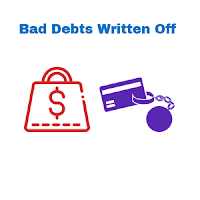Bad Debts Written Off

Accounting For Bad Debts Written Off
Bad Debt Written off means that the amount of goods sold to customers or services rendered to them are actually not recovered from our customer (Accounts Receivable) within the time specified. It is a Loss or Expense to the business and it is recorded in Bad Debts Expense T Account or Ledger and then closed by transferring to Income Statement on Expense Side at the end of the Accounting Period. Bad Debt Expense is considered as the actual loss to the Revenue from Uncollectible Accounts who failed to pay on time. Bad Debts Expense is different from Uncollectible Accounts Expense as bad debts is actually the real loss to the the business while Uncollectible Account Expense is an estimated expense that will happen in future if the customer will fail to pay.
Bad Debts Written Off Accounting Journal Entry
Suppose, Mr. A is our customer to whom we sold goods worth Rs. 50000 who failed to pay the amount within the period of 2 months. Now, such non-payment of dues becomes an expense or loss for our
business, then we need to make an Adjustment, so the following Accounting Journal Entry is passed in the Book or Journal of the business:
Bad Debts Expense a/c 50000
Mr. A 50000
(Amount of Bad Debts Written Off Recorded)
Also Check Out, “What is Allowance For Doubtful Accounts”
Bad Debts is recorded in Income Statement / Profit and Loss Account. There is no balance of Bad Debts Expense Account as it is a temporary account, so it is closed to Income Summary Account at the end of accounting period, However, the Normal Balance of Bad Debts Expense is Debit when it is incurred due to non-payment from customers and when we close it to Income Summary Account, it is credited.
Actual Bad Debt may be recovered from our customer and, in such case, such Bad Debt becomes Good Debt and it is a Bad Debt Recovery, so we open an account named as Bad Debts Recovered
Account.
Comments